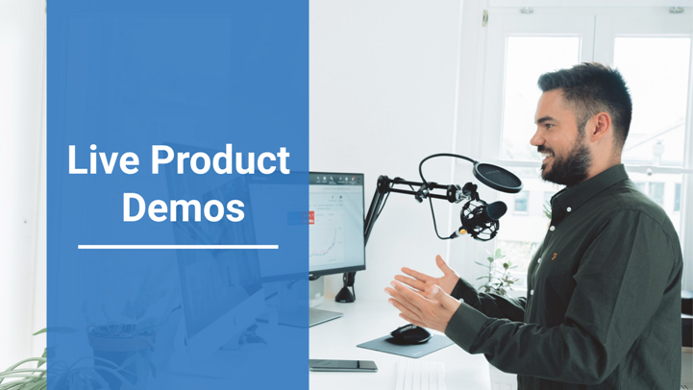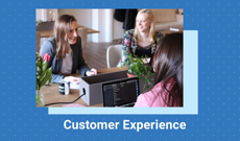Have a product to sell? Then you cannot do without a product demo. Product demos are central to any sales process. They allow you to showcase benefits, justify pricing, work with objections, and even inspire your prospects to buy from you on the spot.
Product demos can be given in-person or online, they can be pre-recorded or delivered in real-time. You can treat a product demo as a presentation given to a wide audience—and sometimes it’s the only way to scale it. But the most effective way to close a sale is to give a one-to-one live demo to your prospective customer.
So what do you need to nail a product demo as a sales rep? In this article, we’ll share 9 great tips for successful conversations and closing deals.
#1 Do Your Research
Live product demos are extremely expensive. You not only need a sales rep and webinar software but also training, several hours for preparation and actual demoing, and a flawless sales deck.
So even before you start thinking about executing the demo, make sure it makes sense to host one. Do your prospects qualify for the live demo? Is there a decision-maker among the audience? What are their pain points? Does your product feel like a good fit for their goals?
It’s also worth considering your client’s place in a buyer’s journey: if they only just start to explore the product, it may be too early to demo. Wait till they investigate on their own a bit and understand what they are looking for—your conversation will turn out much more fruitful.
#2 Write a Script
Even if you know the product inside out—and especially if you don’t—write a script. Then run through the lines a couple of times with a colleague before the actual demo. This will help you feel more confident, stay on track with the conversation, and tackle some of the trickier questions your clients may have.
But don’t read from the slides. Don’t even show them to your clients, as reciting a written text may feel artificial and mechanical, and spoil the impression. Besides, your prospects are here to see your product, which is much more powerful than any PowerPoint presentation.
#3 Make the Demo Personal
The temptation to show all the benefits of your product may be strong, but you must resist it. Bombarding prospects with features will leave them confused and overwhelmed, and you will probably lose them right there.
Here’s what you can do to help your clients see the product will work for them:
- Focus on your prospect’s use case. Show them how easily and effectively the problem solves the problem in as few steps as possible.
- Use relevant dummy data. You can even take a logo from their website if it’s available, and inject it into your product to create a sense of ownership.
- Ask for the appropriate materials in advance, and don’t be afraid to use them. A tangible, hands-on experience with the product will convey your message much faster.
#4 Keep It Short
There’s no hard and fast rule about the duration of a perfect demo, but evidence shows that the most successful product demos are under 15 minutes long. You may feel panicky when thinking about it, but your prospects probably feel the same about sitting through another 45–60 minute presentation. And if you have done your research and discovered the customer’s pain points, 15 minutes will be more than enough to get your point across.
#5 Don’t Save the Best Part for Last
A product demo doesn’t equal a product tour. Don’t try to teach your clients to use the product, delaying the moment of success. Take the greatest value your solution brings to this specific customer and hit them with it from the start. This will leave your audience intrigued and excited, and they will undoubtedly have lots of questions. Which is a good thing! By answering these questions you’ll be able to go into the level of detail relevant to them without losing time on explaining the things they don’t need.
#6 Keep It Conversational
Sticking to the agenda is important, but it is equally important to stay flexible. Your demo should be a dialog between your prospects and you. This helps to build trust and work with objections the moment they appear.
A great way to achieve this is to move the Q&A session traditionally held at the end of the demo to the beginning. You can ask the clients about their expectations from the demo and play off them. Make pauses between the sections and ask follow-up questions to keep the conversation flowing.
However, make sure that you are the one in control of the dialog and you are the one who decides when to discuss such things as pricing or technical issues.
For instance, according to Gong who has analyzed over 70,000 sales conversations, pricing discussions happen toward the end of the conversation in successful demos. So it’s a good idea to deflect the pricing questions until then by gently redirecting the conversation to values. Or, if you choose to establish the meeting agenda at the beginning of your demo, you can openly tell the prospects when you’ll be discussing the pricing.
#7 Be Wary of Generic Social Proof
The product demo is a fantastic way to show off your best clients, but don’t just brag. Simply name-dropping some big brands can actually do more harm than good. The prospect may feel like their cases are very different, and if your service is a good fit for Tesco, Microsoft, or Burger King, it doesn’t automatically mean it will also be a good fit for them.
A better way to address social proof is by finding a few companies from the same industry as that of your prospects—preferably, with similar cases. But even if the cases are different, it may work in your favor: you’ll spark the prospects’ interest while inspiring new ways of applying your product that they haven’t thought about before.
Another good strategy is to tell your prospects how many companies from their industry are already using your product. This will communicate to them that their entire environment is aware of your solution and trusts it.
#8 Test Everything before the Demo
Nothing breaks the flow of the conversation like a technical issue, especially an avoidable one. To make sure you won’t experience any hiccups along the way, check everything beforehand: webinar software, headset, room, and the product, of course. Never use a beta version of your product—only the tested, official one. Even if the current version is missing an important feature, it’s better to give a timeline of its release than show something half-baked and possibly buggy.
#9 Discuss the Next Steps
Sometimes, the prospect will be ready to go with your product the moment the demo is over. Other times, they will need a bit more time to come forward with a decision. Your goal is to find out what their buying process is, so you know when the best time to follow up is, what roadblocks you can come across, and what the timeline is. The demo is just a step down the sales funnel, and it’s important not to lose track of the ultimate goal—which is closing the deal.
A great way to keep your finger on the pulse is to send your prospect a follow-up proposal you can track. Such as this one:
TriDigital IT Marketing Proposal
Create yours
Seeing how often your prospect opens the document and what content they are most interested in will give you valuable insights. You’ll see their level of engagement and will be able to determine the best time for a follow-up call.
FlippingBook helps you create trackable online brochures for sales and marketing. Give it a try to learn more.
Conclusion
A product demo may seem easy, but in fact, you need a great deal of professionalism, practice, and the right tools to make it a success. However, if you listen to your customers’ needs and pour a bit of your time into preparation, it will definitely pay off in the form of shorter sales funnels and a greater number of closed deals.





